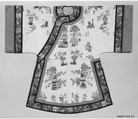Woman's informal robe
Not on view
Embroidered in brightly colored silks and gold on the woolen ground of this robe is a roughly symmetrical arrangement of the "hundred antiques," lavishly complemented with fruit and flowers. At the bottom center of the robe, between containers of narcissus flowers, the scholarly tradition is represented by brushes, a scroll of silk or paper for calligraphy or painting, coral branches, and a fly whisk, all objects associated with the literati.
A little higher, below vessels containing sumptuous fullblown peonies and other flowers, is a long slender object shaped like a mushroom at one end and seen here with a tassel at the other end. This implement is called a ruyi, and as it figures in rebuses to symbolize the fulfillment of a wish, the presence of a ruyi often signals that a word puzzle is at hand. Here it is seen with a bowl containing a peach and a Buddha's-hand citron, fruits associated with longevity and prosperity. Represented on the inner part of the sleeves on either side of this robe are utensils for burning incense, each set consisting of an incense burner, a small round box for storing incense, and a cylindrical holder containing a spatula and tongs for manipulating the burning incense. Sets of utensils for burning incense were indispensable accessories in a scholar's studio.
Due to rights restrictions, this image cannot be enlarged, viewed at full screen, or downloaded.

